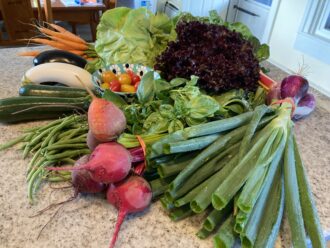In the 1990s, when Roxbury Farm (now known as Roxbury Farm CSA) was in its pioneering phase, apprentices were a key part of our workforce. One of our apprentices, Katie Smith (currently the co-owner of the Farm at Miller’s Crossing in Hudson, N.Y.), complained, correctly, that it was difficult to learn how to farm through on-the-job instruction alone. Her sentiment reflected a broad dissatisfaction among apprentices with the lack of intentional training within apprenticeship programs. During my own farmer training in the Netherlands, our apprenticeships were guided by our schools and were supported by a strong theoretical foundation, so I knew we could do much better. In response, David Inglis of Mahaiwe Harvest CSA and I called together 13 other farmers in the Hudson and Pioneer Valleys for a meeting to reflect on what should be offered to an apprentice working on our farms. As our collective knowledge proved greater than what we could offer individually on our farms, the Collaborative Regional Alliance for Farmer Training (CRAFT) was born.
To provide our apprentices with better guidance, I decided to write down all the daily instructions for growing and harvesting our crops. This process spanned several years, and resulted in the first edition of the Roxbury Farm Crop and Harvest Manuals, published in 2001. Because I wrote them for our apprentices and employees, they referenced tools and methods specific to our farm. At the end of their employment, apprentices kept their own copies, which helped them during their own pioneering phase in building a new farm.
Over time, word got out about the manuals, and when apprentices from the other farms came for a CRAFT visit, many requested a copy. To offset printing costs and make them easier to share, I made the manuals available through our website. At conferences, people would often stop me and thank me for having made the manuals available, telling me it was one of the most important tools available to them in the early phase of their farming career.
The manuals went through several editions and continued to be written exclusively from the Roxbury Farm perspective. Roxbury Farm grew from a 5-acre vegetable operation in 1990 to a 370-acre farm producing vegetables, beef, and lamb for 1,100 CSA shareholders in 2005. In 2014, I left Roxbury Farm–which continues to thrive today under new ownership–to start a small-scale farm from scratch in the foothills of the Adirondacks, named Philia Farm. Here, our goal is to conduct research on the optimal practices in vegetable and vegetable seed production while providing fresh produce to a small local community.
This experience gave me a renewed appreciation of how scale affects production practices, and when I reread the manuals, I realized their limitations. In response, I applied for and received a grant from Northeast SARE in 2020 to update and broaden the manuals (project FNE20-950). This involved polling 60 exemplary farmers in New England and beyond about their production and harvest practices. Vegetable specialists from Cornell Cooperative Extension helped with the questionnaire and interpretation of the results. They also reviewed the final copies to ensure compliance with the Food Safety Modernization Act. This expansion prompted me to rename them the Northeast Crop Production and Harvest Manuals.
The Northeast Crop Production Manual includes tips on planning rotations, preparing the soil, planting and transplanting, and managing pests. It’s most useful for organic farmers in the Northeast, and also for farmers in other parts of the country with a similar four-season climate. The Northeast Harvest Manual addresses the timing and methods for harvesting crops, along with post-harvest handling and storage considerations. (Note: In the online version, both manuals have been combined, so for example there is only one arugula page, and it includes both crop production and harvest information. The PDF versions are two separate manuals.)
The information in the latest edition of the manuals is written to be relevant to both mid-size and smaller-scale operations.
While the new manuals continue to be a bit Northeast-centric, I have tried to keep farmers all over the United States in mind. New links provide in-depth knowledge on specific topics or practices. These links were carefully selected to appeal to a broad audience.
I extend my sincere gratitude to all the participating farmers, extension specialists, and SARE staff for their support and valuable contributions over the years. We hope the following information will help your operation become more successful and allow you to adopt the most sustainable practices in your operation.
Jean-Paul Courtens
Philia Farm, Johnstown, N.Y.
This material is based upon work that is supported by the National Institute of Food and Agriculture, U.S. Department of Agriculture through the Sustainable Agriculture Research and Education (SARE) program. Any opinions, findings, conclusions, or recommendations expressed in this publication are those of the author(s) and should not be construed to represent any official USDA or U.S. Government determination or policy.
